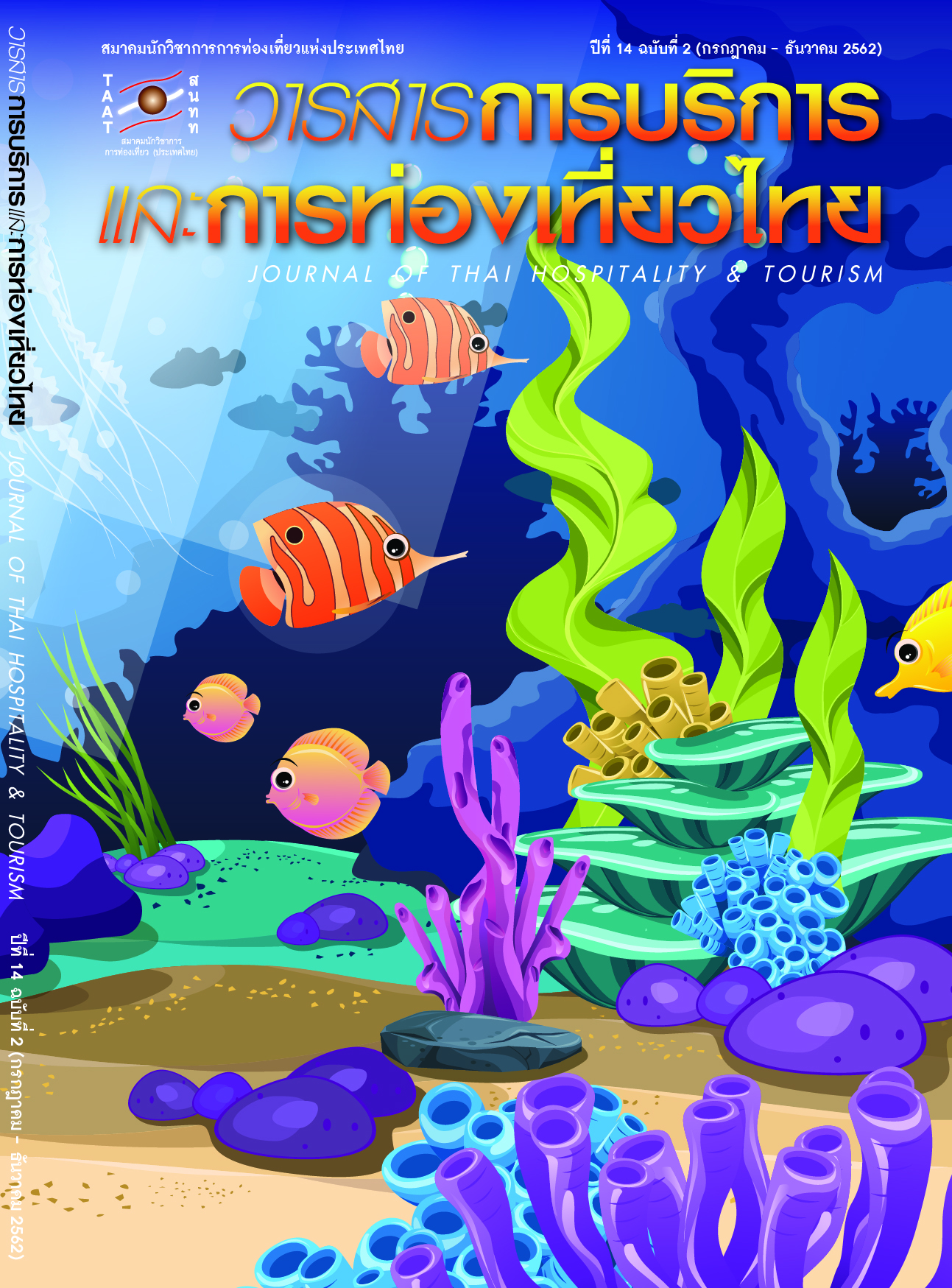ความหมายและรูปแบบการให้บริการของ Wellness Tourism ในพื้นที่ภาคเหนือตอนบนของประเทศไทย
Main Article Content
บทคัดย่อ
การวิจัยเรื่อง ความหมายและรูปแบบการให้บริการของ Wellness Tourism ในพื้นที่ภาคเหนือตอนบนของประเทศไทย ได้แบ่งขั้นตอนการทำวิจัยเป็น 2 ส่วน คือ ส่วนแรกได้ทำการกำหนดนิยามและศึกษารูปแบบของ Wellness Tourism ของพื้นที่ภาคเหนือตอนบน 3 จังหวัด คือ เชียงใหม่ เชียงราย และแม่ฮ่องสอน โดยเก็บข้อมูลจากการสนทนากลุ่มกับผู้ที่เกี่ยวข้องกับ Wellness Tourism ได้แก่ อาจารย์ ผู้ทรงคุณวุฒิ รวมทั้งบุคคลากรจากหน่วยงานของรัฐและเอกชน จำนวน 10 ราย ส่วนที่ 2 ได้ทำการศึกษาการดำเนินงานของผู้ประกอบการในพื้นที่ภาคเหนือตอนบน 3 จังหวัด คือ เชียงใหม่ เชียงราย แม่ฮ่องสอน ในการให้บริการ Wellness Tourism เพื่อทราบถึงแนวทางการให้บริการ ลักษณะของธุรกิจ และความพร้อมในการให้บริการของธุรกิจแต่ละราย ได้ทำการเก็บข้อมูลโดยการสัมภาษณ์เชิงลึกกับผู้ประกอบการ 10 รายใน 3 จังหวัด แบ่งเป็นเชียงใหม่ 6 ราย เชียงราย 2 ราย และแม่ฮ่องสอน 2 ราย
ผลการวิจัยจากการสนทนากลุ่ม สามารถให้นิยามของ Wellness ได้ว่า หมายถึง ภาวะความสมดุลทางกาย ใจ และจิตวิญญาณ ที่ก่อให้เกิดความสุข และได้ให้คำนิยามของ Wellness Tourism ว่าหมายถึง การเดินทางท่องเที่ยวที่เน้นกิจกรรมเพื่อส่งเสริมความสมดุลของกาย ใจ และจิตวิญญาณ ซึ่งจะต้องมีการให้บริการทั้งในส่วนของสถานที่ และในส่วนของประเภทของกิจกรรมสำหรับ Wellness tourism ได้แบ่งเป็น 3 กลุ่ม ได้แก่ 1) กิจกรรมแบบ Active เป็นกิจกรรมที่ต้องทำด้วยตัวเอง 2) กิจกรรมแบบ Semi-active เป็นกิจกรรมที่มีผู้ช่วยแนะนำเพื่อให้ผู้เรียนสามารถดำเนินการต่อไปได้ด้วยตัวเอง และ 3) กิจกรรมแบบ Passive เป็นกิจกรรมที่มีผู้อื่นเป็นผู้ทำให้
เมื่อพิจารณาการดำเนินงานของผู้ประกอบการในการให้บริการ Wellness Tourism ของ 3 จังหวัด คือ เชียงใหม่ เชียงราย แม่ฮ่องสอน พบว่ามีรูปแบบที่แตกต่างกันเนื่องจากแต่ละพื้นที่มีจุดเด่นที่แตกต่างกัน ส่วนด้านสิ่งอำนวยความสะดวกที่เหมาะสมของ Wellness tourism พบว่าควรเน้นที่ความสะดวกในการเข้าถึง นอกจากนี้ยังพบว่าผู้ประกอบการใน 3 จังหวัดมีศักยภาพในการให้บริการที่แตกต่างกันไปตามจุดเด่นของแต่ละพื้นที่
Article Details
References
[2] Chen, J. S., Prebensen, N., & Huan, T. C. (2008). Determining the Motivation of Wellness Travelers. International Journal of Tourism and Hospitality Research, 19(1), 103-115.
[3] Georgiev, G. & Vasileva, M. T. (2010). Conceptualization and Classification of Balneo, Spa and Wellness Establishments in Bulgaria. UTMS Journal of Economics, 1(2), 37-44.
[4] Hjalager, A. & Konu, H. (2010). Cosmeceuticals in Wellness Tourism – Cases of Co-branding and Co-creation. Proceeding of the Travel and Tourism Research Association Europe 2010, 1-3 September 2010, Budapest Hungary, 67-75.
[5] Huijbens, E. H. (2011). Developing Wellness in Iceland: Theming Wellness Destinations the Nordic Way. Scandinavian Journal of Hospitality and Tourism, 11(1), 20-41.
[6] Jariangprasert, Nittaya., Maneesong, Orachorn., et al. (2005). Development of Knowledge in Ecotourism of Mae Sarieng District, Maehongsorn Province: The Case of Tambol Mae Hoh. Research Report. Faculty of Business Administration, Chiang Mai University.
[7] Kaosa-ard, Mingsarn. (2005). Retained Value of the Tourism Industry of Thailand. Research Report. Social Research Institute, Chiang Mai University.
[8] Királová, K. (2010). Health Spa and Wellness – Competition or Supplement? The Czech Republic case. Proceeding of the Travel and Tourism Research Association Europe 2010. 1-3 September 2010, Budapest Hungary, 121-143.
[9] Komppula, R. & Pesonen, J. (2010). Rural Tourism, A Form of Wellbeing Tourism?. Proceeding of the Travel and Tourism Research Association Europe 2010. 1-3 September 2010, Budapest Hungary, 144-153.
[10] Konu, H. (2009). Identifying Potential Wellbeing Tourism Segments in Finland. Tourism Review, 65(2), 41-51.
[11] Konu, H., Tuohino, A., & Komppula, R. (2010). Lake Wellness: A Practical Example of A New Service Development (NSD) Concept in Tourism Industries. Journal of Vacation Marketing, 16(2), 125-139.
[12] Kucukusta, D., & Heung, V.C.S. (2012). The Problems of Developing Wellness Tourism in China: From Supply Perspective. Journal of China Tourism Research, 8, 146-158.
[13] Laing, J., Voigt, C., Wray, M., Brown, G., Weiler, B., Howat, G., & Trembath, R. (2010). Sand, Surf, Spa and Spirituality? Examination of A Scoping Study of Medical and Wellness Tourism in Australia. Proceeding of the Travel and Tourism Research Association Europe 2010. 1-3 September 2010, Budapest Hungary, 164-174.
[14] Mueller, H. & Kaufmann, E. L. (2001). Wellness Tourism: Market Analysis of A Special Health Tourism Segment and Implications for Hotel Industry. Journal of Vacation Marketing, 7(1), 5-17.
[15] Pearcy, D. H. & Lester, J. (2012). Capitalizing on Emerging Tourism Trends: An Exploratory Examination of Jamaica's Wellness Tourism Sector within An Innovation Systems Framework. International Journal of Business, Marketing, and Decision Sciences, 5(2) (Fall 2012), 121-136.
[16] Ponocny, I. & Lund-Durlacher, D. (2010). Analysis and Classification of Wellness Hotels in Austria. Proceeding of the Travel and Tourism Research Association Europe 2010. 1-3 September 2010, Budapest Hungary, 184-195.
[17] Priszinger, K., Formádi, K., & Mayer, P. (2010). Conscious or Trendy? How do Fashions and Trends Influence Consumer’s Selection Criteria in Health-related Tourism?. Proceeding of the Travel and Tourism Research Association Europe 2010. 1-3 September 2010, Budapest Hungary, 272-281.
[18] Ravichandran, S. & Suresh, S. (2010). Using Wellness Services to Position and Promote Brand India. International Journal of Hospitality & Tourism Administration, 11, 200-217.
[19] Rodrigues, Á., Kastenholz, E., & Rodrigues, A. (2010). Hiking as a Wellness Activity-An Exploratory Study of Hiking Tourists in Portugal. Journal of Vacation Marketing, 16(4), 331-343.
[20] Smith, M. & Kelly, C. (2006). Wellness Tourism. Tourism Recreation Research, 31(1), 1-4.
[21] Stanciulescu, G. C. & Molnar, E. (2010). Segmentation and Positioning Products and Destinations in Health and Wellness Tourism. Proceeding of the Travel and Tourism Research Association Europe 2010. 1-3 September 2010, Budapest Hungary, 326-334.
[22] Tourism Research and Marketing. (2006). Medical Tourism: A Global Analysis. London: ATLAS, p.14.
[23] Voigt, C. & Laing, J. (2010). “Australian Wellness Tourism Providers: Definition, Typology, and Current Status. Proceeding of the Travel and Tourism Research Association Europe 2010. 1-3 September 2010, Budapest Hungary, 383-398.
[24] Voigt, C., Brown, G., & Howat, G. (2011). Wellness Tourists: In Search of Transformation. Tourism Review, 66 (1/2), 16-30.
[25] Wellness Tourism Worldwide. (2011). 4WR: Wellness for Whom, Where, and What? Wellness Tourism 2020. Hungary: Wellness Tourism Worldwide.

